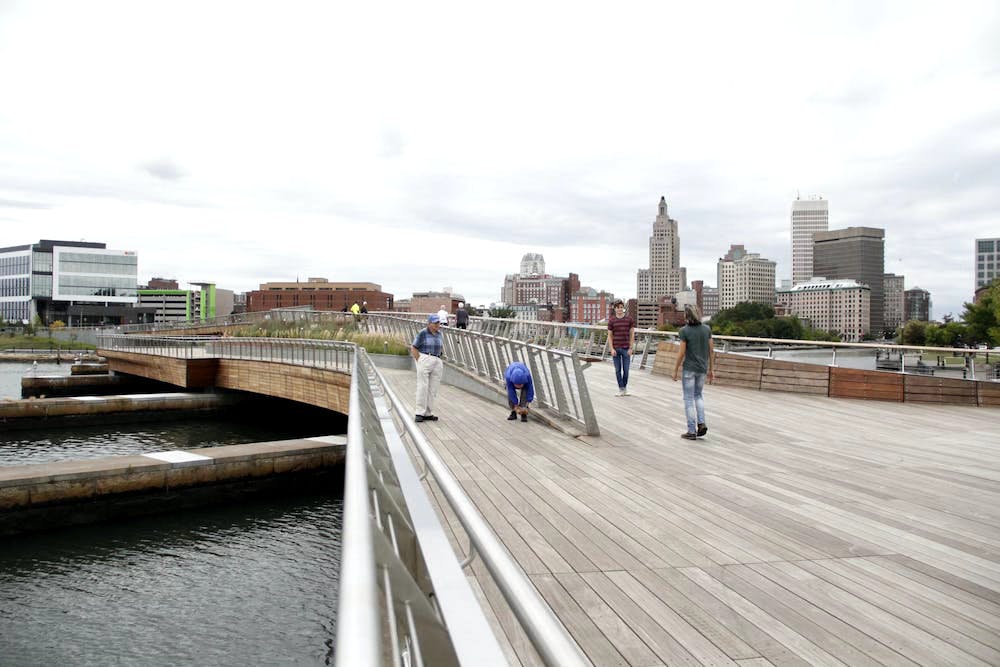The University would pay an average of $8.7 million annually to the city of Providence under two proposed voluntary payment agreements announced at City Hall Tuesday afternoon. The agreements, which now await approval from Providence’s City Council, were the product of months of negotiation between the city and the four private higher-education institutions that have signed on to the agreements.
The first agreement, a memorandum of understanding signed between Brown, the Rhode Island School of Design, Providence College and Johnson and Wales University, would direct more than $177 million to the city’s coffers over 20 years, $128.7 million of which would come from Brown. The second, a separate memorandum of agreement solely between Brown and Providence, accounts for an additional $46 million over the next 10 years.
If approved by the City Council, the proposed agreements would result in more than $174 million in voluntary payments from Brown to Providence between 2024 and 2043. Direct monetary payments from Brown to the city, though, can be decreased through University activities that are deemed to provide direct tax revenue to the city — such as development projects and collaborations or the sale of tax-exempt institutional properties, returning parcels to the commercial tax rolls.
The University confirmed that negotiations were underway this winter, and in the time since, several student demonstrations demanded that Brown increase its annual contributions to the city in lieu of taxes.
As a non-profit institution, Brown is exempt from paying property taxes on its educational buildings but does pay taxes on its commercial holdings. A 2022 report from the Providence Finance Department estimated that the University would pay nearly $50 million annually if it were eligible to be taxed on all of its property, The Herald previously reported. For fiscal year 2023, Brown University is expected to pay $4.5 million in voluntary payments to the city, the Boston Globe previously reported.
At a protest last April, the Brown Activist Coalition called upon Brown to pay $15 million annually to the city — a “meager amount compared to what they owe,” Niyanta Nepal ’25, co-president of Students for Educational Equity and rally organizer, told the crowd at the demonstration.
Though the University would pay an average of $8.7 million to the city annually under both agreements, the exact amount will change year by year. Without accounting for potential payment reduction credits for investments in public projects or new tax revenue originating from Brown validated by a third-party accounting firm, the first upcoming payment in 2024 would climb above $11 million and then peak in 2025, while the payment in 2034 will hover just above $6 million as the Brown-specific agreement expires. In 2043, the final year of the memorandum of understanding, Brown will pay more than $8 million.
“We've come to an agreement that sets our city now as a national example for how to better define the relationship between institutions of higher education who happen to be property tax-exempt, but are so vital to the success of our city,” said Providence Mayor Brett Smiley in remarks at a press conference Tuesday afternoon.
“From the beginning, we negotiated around shared priorities — fairness, equity and ensuring that Providence has the financial security to sustainably grow,” he added.
The University and the city previously made voluntary payments under two agreements — a memorandum of understanding signed in 2003 with the city’s other private colleges, and a memorandum of agreement signed in 2012 between only Brown and the city. The two memorandums expired in 2023 and 2022, respectively.
Providence’s tax-exempt institutions commit to voluntary payments
Under the four-school memorandum of understanding, payments to the city would increase annually, growing by 2% each year for the first five years, then by 2.5%, 2.75% and 3% for the three following five-year periods.
All or a substantial majority of the voluntary payments would be “especially” targeted to five priority areas: pre-K-12 education; equity, diversity and inclusion; community safety and well-being; promotion of the Providence as “a safe, vibrant and inviting place to live, work and learn” and adaptation infrastructure and policy for climate change and climate resiliency.
Under the MOU, the four schools would also match the dollar amount of their direct voluntary payments through community contributions, which can include tax revenue from commercial properties; services provided in public spaces and to city employees; scholarships and financial aid for Providence residents and voluntary contributions to K-12 education.
The city will publicly report these community contributions so that “residents, taxpayers, visitors and members of the university communities know and can see the many ways in which these institutions contribute to the vitality of our city,” Smiley said.
The MOU would also create a “Quality of Life” working group that would create a formalized structure for addressing neighborhood issues and ensuring that the institutions and their neighbors “can work and thrive together,” Smiley said. The group will include officials from city operational departments and representatives from each institution and will meet every other month.
Per the MOU, Providence also committed to maintaining the current Institutional Master Plan process and current zoning ordinance standards for institutional districts, along with increasing enforcement of municipal code violations.
Brown’s payments subject to possible reductions
The University’s $46 million, ten-year memorandum of agreement was the only individual agreement between a school and the city. Under this agreement, the University would contribute $6 million annually for the first two years, $5 million annually for the following two years, and $4 million annually for the remaining six years.
“We've reached this agreement after a series of very constructive, positive negotiations with the city,” said President Christina Paxson P’19 P’MD’20 in her remarks at the press conference. The proposals “reflect our combined and deep commitment to the well-being of Providence, the vibrancy of Providence and the people who live here.”
As a part of the agreement, the City would commit to supporting the University’s property and parking-related priorities — including the acquisition of four blocks in the Jewelry District and one block on Cushing Street adjacent to Pembroke Field, as well as the extension of a parking agreement outlined in the 2012 MOA that allows leasing of street parking spaces in College Hill for use by Brown employees.
The City, through “legislative and administrative actions,” would also support the University’s new Integrated Life Sciences Building construction project in the Jewelry District, according to the Memorandum of Agreement.
Additionally, a “Credits Against Payments Condition” stipulation creates the possibility for the University to reduce its annual voluntary payments in the MOA.
Development projects assisted or funded by Brown or the sale of institutional property — essentially returning tax-exempt parcels to the tax roll — would qualify Brown for a reduction in its annual MOA payment. That reduction would be valued at 50% of the tax revenue returned to the city as a result of either case.
The University can also reduce its annual voluntary payment by the full amount of direct investments in development projects specifically in collaboration with Providence or a private and public sector partner, such as workforce housing, childcare and public parks.
The credit provision “recognizes (Brown’s) activities that create a positive economic impact on the city through incremental tax revenue,” Paxson wrote in an email to the Brown community.
“It is a big step up from where we were previously,” said Isaac Slevin ’25, an organizer with Sunrise Brown and the Brown Activist Coalition, of the new agreements. But Slevin was hesitant to immediately endorse the agreement, noting that it includes several “carve-outs” for the University to reduce its total payment obligations.
“This isn't the end,” Slevin said. “There is a lot more work that has to be done to make Brown a responsible community partner (and) there's a lot to be wary about in this agreement as well.”
On Thursday, the City Council will formally receive the MOU and MOA and refer them to the council’s finance committee for review, Providence City Council President Rachel Miller said at the press conference. Committee members will then vote on whether to send them back to the full council for a ratification vote, which is expected to take place in October, she added.
Clarification: A previous version of this story based on an early press release misstated the average amount the University would pay annually to the city of Providence. This article has been updated to reflect the correct number.

Sam Levine is a University News editor from Brooklyn, New York covering on-campus activism. He is a senior concentrating in International and Public Affairs.

Rhea Rasquinha is a Metro editor covering development and infrastructure. She also serves as the co-chief of illustrations. She previously covered College Hill, Fox Point and the Jewelry District. Rhea is a senior from New York studying Biomedical Engineering.





